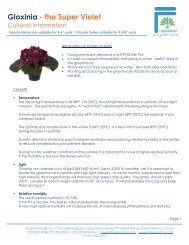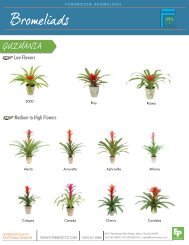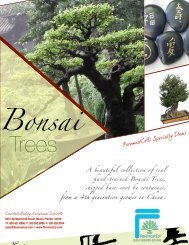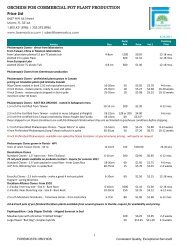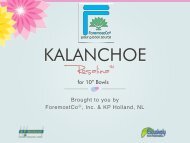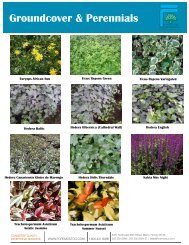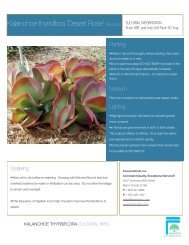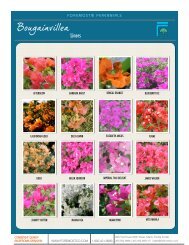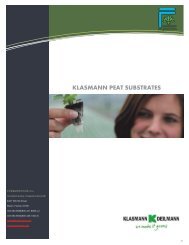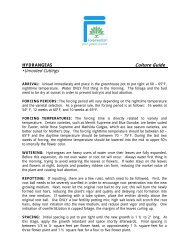Ananas lucidus Pineapple - Cultural Sheet (PDF) - ForemostCo
Ananas lucidus Pineapple - Cultural Sheet (PDF) - ForemostCo
Ananas lucidus Pineapple - Cultural Sheet (PDF) - ForemostCo
Create successful ePaper yourself
Turn your PDF publications into a flip-book with our unique Google optimized e-Paper software.
Micronutrients are also important for the vigorous development of the plants, although the micronutrient needs ofpineapples are lower than most crops. If the grower is using a pre‐formulated fertilizer with micronutrients, this shouldbe enough to supply the plant necessities. Otherwise, a foliar application of a balanced micronutrient formulation twiceduring the growing cycle should suffice.It is important to note that pineapples are very sensitive to high levels of copper and boron. High concentrations ofeither element on fertilizer or fungicide applications may damage leaves of the plants.Insects and Diseases<strong>Pineapple</strong> is fairly resistant to most insect and disease problems. By far, the most serious insect problem in pineapple isscale. The grower should monitor plants closely for initial signs of scale infection, and control it early. Plants thatdevelop a severe scale problem, should be discarded at once to prevent the spread of the insect to healthy plants. Awide spread infestation of scale on pineapple is difficult to control, and it should be prevented.Mites can also become a problem, although less common. Heavy infestation of mites may damage leaves permanentlyand it should be prevented.Most of the fungal problems of the pineapple are associated with cultural mistakes. Pythium and Phytophthora root rotcan be a problem under water soaked conditions and soggy medium. Foliar fungal problems are less prevalent and areusually due to Fusarium or Helmithosporium leaf spot. Preventive fungicide applications can be done under high diseasepressure conditions, and when air circulation is less than ideal.Production TimingsIt is very hard to determine exact production timings for this crop, since it will vary drastically depending on the pot sizeused and the environmental conditions of each grower. For a medium size plant, under favorable environmental andcultural conditions, the grower can expect a vegetative growth period of 8 to 12 months. The vegetative growth cycle isfollowed by the flowering and fruit development cycle, which lasts 3 to 4 months.Flower Induction and Fruit DevelopmentThe pineapple is a short day plant, and under natural conditions may come into bloom during winter months if the planthas reached full maturity. But under nursery conditions, plants are artificially induced to flower using chemical growthregulators. The most widely used chemical for pineapple flower induction is ethephon. This chemical is sold underdifferent brand names (Florel, Ethrel, etc.) and under different concentrations of a.i.<strong>ForemostCo</strong>®, Inc. | Consistent Quality, Exceptional Service | 8457 NW 66 Street, Miami, FL 331661.800.421.8986/305.592.8986 | 305.592.8934‐fax | sales@foremostco.com | www.foremostco.com3
Under most conditions, a solution containing between 25ppm and 100ppm is sufficient to promote flowering. A singleapplication of the ethephon solution (2 to 4 fl oz) in the center of each plant is recommended. In addition, etephon’seffectiveness is greatly increased at higher pH levels. A treatment solution with pH between 8 and 10 significantlyincreases the induction percentages. Calcium hydroxide is one of the options to increase the solution’s pH. Ca(OH) 2 canbe applied to the ethephon solution at a rate of 1oz per 30 gallons.Four weeks after the treatment, the grower will be able to observe the first signs of flowering. A change in the shape ofthe rosette and the elongation of the apical meristem will be the first signs. If some plants do not show physiologicalchanges by 4 weeks after treatment, than the grower may try one additional ethephon treatment.Flower and fruit development will follow a few weeks later. It is worthwhile noting that fruit development and color areintensified by cooler nights. Nigh temperatures in the 60’s and day temperatures in the 80’s are ideal conditions for fruitdevelopment and maturity.Please note that above instructions are only a guide and results depend upon the specificconditions of each producer.<strong>ForemostCo</strong>®, Inc. | Consistent Quality, Exceptional Service | 8457 NW 66 Street, Miami, FL 331661.800.421.8986/305.592.8986 | 305.592.8934‐fax | sales@foremostco.com | www.foremostco.com4




